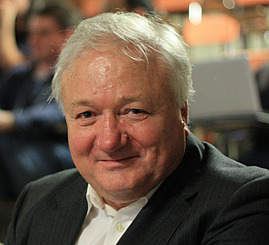Leading Astrophysicist Rashid Sunyaev Appointed Maureen and John Hendricks Visiting Professor

Rashid A. Sunyaev, one of the world’s most distinguished astrophysicists, has been appointed the Maureen and John Hendricks Visiting Professor in the School of Natural Sciences at the Institute for Advanced Study for three years beginning in 2010-11. Sunyaev is Director of the Max Planck Institute for Astrophysics in Munich, Germany, and also serves Chief Scientist of the Russian Academy of Sciences’ Space Research Institute. A leading theoretician who developed the standard model of how black holes devour matter and who has made fundamental contributions to our understanding of the structure of the cosmological background radiation, Sunyaev will be in residence for two months in each of the coming three years to work with Faculty and Members in the School.
Sunyaev’s Visiting Professor Membership is made possible through the generosity of John and Maureen Hendricks. John Hendricks, Founder and Chairman of Discovery Communications, is a Trustee of the Institute, who with his wife Maureen provides funding for science research and higher education through the John and Maureen Hendricks Charitable Foundation.
Scott Tremaine, Richard Black Professor in the School of Natural Sciences, stated, “One of the primary goals of the Institute’s programs in astrophysics is to broaden and develop the research skills of the most promising young astrophysicists, and Rashid is uniquely qualified to do this: he is interested in and knowledgeable about almost every aspect of theoretical astrophysics, he is extraordinarily energetic and interactive, and he loves to talk about science with young people.”
On his appointment, Sunyaev noted, “The first time I heard about the Institute for Advanced Study was in the late 1950s, when I was a high school student in Tashkent, a large and multinational city in Soviet Central Asia. I was very impressed by the constellation of brilliant scientists working at the Institute at that time. It is a great honor to be associated with IAS, and I am pleased to serve as the first Maureen and John Hendricks Visiting Professor to pursue my scientific interests alongside the Institute’s Faculty and Members.”
An annual visitor to the School since 2004, Sunyaev shared the 2008 Crafoord Prize of the Royal Swedish Academy of Sciences with Edward Witten, Charles Simonyi Professor in the School of Natural Sciences and Maxim Kontsevich, former Member (1992-93) in the School of Mathematics, for their work in astronomy and mathematics, respectively. The citation for Sunyaev noted his “decisive contributions to high-energy astrophysics and cosmology, in particular processes and dynamics around black holes and neutron stars and demonstration of the diagnostic power of structures in the background radiation.” This radiation provides critical information about the Big Bang, and has enabled astrophysicists to determine the size, age, and geometry of the universe to an accuracy of a few percent. Sunyaev’s work with Nikolai Shakura showed that matter accreted by a black hole formed a thin, rapidly rotating disk known as an accretion disk. The Shakura-Sunyaev disk is the keystone of our understanding of how quasars shine, and their 1973 paper is the most-cited theoretical paper in astrophysics. With Yakov Zel’dovich, he predicted the Sunyaev-Zel’dovich effect, which describes how the ionized gas in giant clusters of galaxies scatters the cosmic microwave background radiation; the “SZ-effect” is now being exploited by an armada of telescopes—in space, in Chile’s Atacama Desert and even at the South Pole—to explore the evolution of structure in the universe and the formation of galaxies over the entire history of the universe.
Born in Tashkent, Uzbekistan, in 1943, Sunyaev earned his Ph.D. (1968) and Doctor of Sciences degree (1973) from Moscow State University. From 1974-82, Sunyaev was Head of the Laboratory of Theoretical Astrophysics at the Space Research Institute in Moscow. He was Professor at the Moscow Institute of Physics and Technology from 1975-2001, while serving as Head of the High Energy Astrophysics Department at the Space Research Institute from 1982-2002. Chief Scientist at the Space Research Institute since 1992, Sunyaev has been Director of the Max Planck Institute for Astrophysics since 1996. In addition to the Crafoord Prize, Sunyaev has received a range of awards including the King Faisal International Prize for Science (2009), the Gruber Cosmology Prize (2003), the Heineman Prize in Astrophysics (2003) and the Gold Medal of the Royal Astronomical Society (1995). He holds memberships in academies around the world, including the Russian Academy of Sciences, the Royal Society of London, the Royal Netherlands Academy of Arts and Sciences, the German Academy of Natural Sciences Leopoldina and the U.S. National Academy of Sciences.
About the Institute for Advanced Study
The Institute for Advanced Study is one of the world’s leading centers for theoretical research and intellectual inquiry. The Institute exists to encourage and support curiosity-driven research in the sciences and humanities—the original, often speculative thinking that produces advances in knowledge that change the way we understand the world. Work at the Institute takes place in four Schools: Historical Studies, Mathematics, Natural Sciences and Social Science. It provides for the mentoring of scholars by a permanent Faculty of approximately 30, and it ensures the freedom to undertake research that will make significant contributions in any of the broad range of fields in the sciences and humanities studied at the Institute.
The Institute, founded in 1930, is a private, independent academic institution located in Princeton, New Jersey. Its more than 6,000 former Members hold positions of intellectual and scientific leadership throughout the academic world. Thirty-three Nobel Laureates and 40 out of 56 Fields Medalists, as well as many winners of the Wolf and MacArthur prizes, have been affiliated with the Institute.